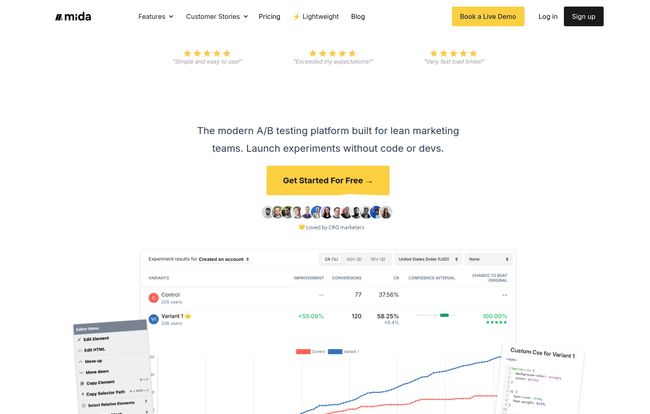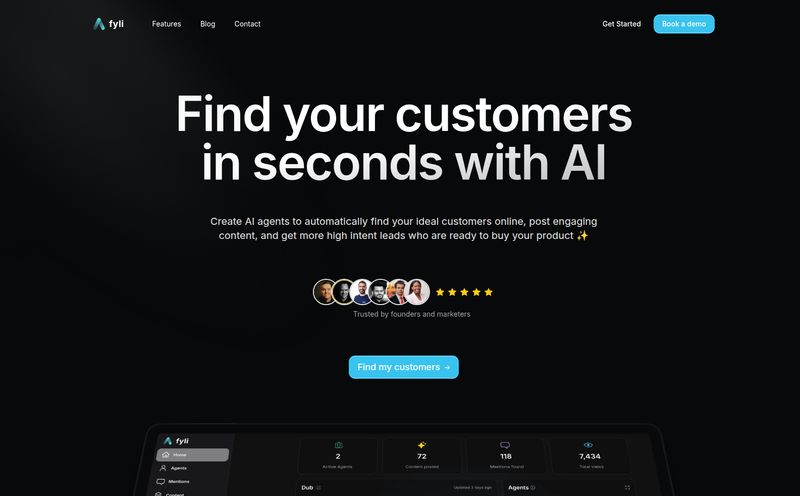For years, we in the SEO and CRO world have been stuck between a rock and a hard place. We know, we absolutely know, we need to be testing. A/B testing isn't just a nice-to-have; it's how we turn guesswork into revenue. But so many of the platforms out there feel... heavy. They're the digital equivalent of an anchor. You load up their script, and you can practically hear your Core Web Vitals groaning in protest. Your page speed tanks, your bounce rate ticks up, and you start to wonder if the potential conversion lift is even worth the SEO hit.
I've been there. I've argued with developers about bloated JavaScript and watched my Lighthouse scores plummet after installing a new testing tool. So when I heard about a platform called Mida, touting a "super lightweight script," my curiosity was piqued. But, you know, I was also skeptical. Everyone claims to be fast. But is it true? I decided to take a look myself.

Visit Mida
So, What is Mida, Anyway?
At its heart, Mida is an A/B testing platform built for what they call "lean marketing teams." I'd just call it 'built for people who have better things to do than fight with their software.' It's designed to let you run conversion experiments—like classic A/B tests, split URL tests, and more—without needing a degree in computer science. It plays nice with all the usual suspects: WordPress, Shopify, Webflow, and, most importantly, Google Analytics 4. Think of it as the spiritual successor to the much-missed Google Optimize, but built for the modern, speed-obsessed web.
The One Feature That Actually Changes Everything: Speed
Okay, let's cut to the chase. Mida has a lot of cool features, which we'll get to. But the single most important thing, the thing that made me sit up and pay attention, is its performance. They talk about their pixel being "super small and FAST!" and from my experience, they aren't kidding. The script is genuinely lightweight. This isn’t just a marketing line.
Why does this matter so much? Because a slow site kills conversions. It's that simple. A one-second delay in load time can reduce conversions by up to 7%. That's a statistic from a Portent study that gets thrown around a lot, but it's true. Mida feels like it was built by people who actually understand this. Swapping out a heavier testing tool for Mida is like trading in your old clunker for a sports car—you get all the power, but it feels light and responsive.
A Closer Look at Mida's Core Abilities
Speed is great, but a tool has to be useful too. Fortunately, Mida isn't a one-trick pony. It's got a solid set of abilities that cover the needs of most marketers and then some.
A/B Testing for a Mixed-Skill Crew
One of my favorite things is the dual-editor approach. It has a no-code visual editor that's perfect for marketers who want to, say, change a headline, swap an image, or switch a button color. It’s intuitive and works just like you'd expect. But then, it also has a code editor. This is brilliant. It means your developer can jump in and implement more complex changes without being constrained by a WYSIWYG interface. It’s a setup that respects both marketing agility and developer precision.
A GA4 Integration That Just Works
Ever since Google pulled the plug on Universal Analytics, getting clean data between your testing platform and GA4 has been... a thing. Some integrations are clunky. Mida’s integration, on the other hand, is refreshingly straightforward. You can push your experiment data directly to GA4, which lets you analyze results alongside all your other site metrics. For anyone serious about data, this native connection is non-negotiable.
A Little Help From Our AI Friends
I'll admit, I roll my eyes a bit when every new tool has "AI" slapped on it. Sometimes it's just a gimmick. Here, it’s actually quite useful. Mida has an AI-suggested copywriting feature that can help you brainstorm new headlines or button text when you're feeling stuck. It also uses AI to assist with goal verification, which can save a lot of time on setup. It’s not going to write your whole campaign for you, but it’s a genuinely helpful creative partner.
Let's Talk Money: The Mida Pricing Structure
Alright, the all-important question: what's this going to cost? Mida has a pretty clear "pay as you grow" model, which I appreciate. No hidden fees or confusing credit systems.
| Plan | Price | Who It's For |
|---|---|---|
| Forever Free | $0 / month | Small sites or anyone who wants to try it out. Includes 25,000 monthly test users, but with some limits on the number of projects and tests. |
| Growth | $199 / month | Most growing businesses. You get 100,000 users (with overages available), unlimited everything, and advanced features like server-side testing and integrations. |
| Enterprise | Custom | Large-scale operations needing dedicated support, SLAs, and custom solutions. |
That Forever Free plan is genuinely impressive. 25,000 users is more than enough to get meaningful results on a smaller site or to just kick the tires thorougly before committing. For most serious businesses, the Growth plan is the sweet spot.
The Good, The Bad, and The Honest Truth
No tool is perfect, right? Here’s my honest breakdown of where Mida shines and where you might feel a pinch.
What I Genuinely Like About Mida
First off, the speed. I know I keep saying it, but it's the main event. The lightweight script is a massive win. Second, the user experience is just... clean. It doesn't feel cluttered or overwhelming. The combination of a generous free plan, easy GA4 integration, and the helpful (not gimmicky) AI features makes for a really compelling package. The inclusion of cross-domain testing right in the free plan is also a fantastic touch that you often have to pay for elsewhere.
Where It Could Improve
On the flip side, the limitations of the free plan—specifically on the number of concurrent projects and tests—might be a bit tight for active testers. It's a sandbox, as they say, not a full-blown workshop. The other thing to watch is the pricing on the Growth plan. While $199 is competitive, the usage-based overage fees for traffic above 100,000 MTUs could add up quickly for high-traffic sites. Finally, gating server-side testing behind the paid Growth plan is understandable, but it's something teams looking for that specific functionality need to be aware of from the start.
So, Who is Mida Actually For?
After spending some time with it, I have a pretty clear picture of the ideal Mida user. This platform is perfect for:
- Small to Medium-Sized Businesses (SMBs) who need a powerful testing solution without an enterprise price tag.
- Lean Marketing Teams and solopreneurs who need to be efficient and can't afford to waste time on a clunky interface.
- Shopify, WordPress, and Webflow users looking for a tool that integrates smoothly with their platform.
- Anyone burned by slow A/B testing tools in the past who puts a premium on site performance and SEO.
If you're a massive enterprise with incredibly complex, multi-team security requirements, you might look at their Enterprise plan or other solutions. But for the vast majority of us in the trenches, Mida hits a real sweet spot.
Frequently Asked Questions
1. How hard is Mida to set up?
Honestly, it's pretty simple. You just add a small snippet of code to your site's header. If you've ever installed Google Analytics or a Facebook pixel, you'll feel right at home. They have clear instructions for GTM, Shopify, WordPress etc.
2. Will Mida actually slow down my website?
This is its main claim to fame. Because the script is so small and loads asynchronously, its impact on your site's load time is minimal, almost negligible. Compared to other major players in the space, it's incredibly fast.
3. Is the Mida free plan good enough to start with?
Absolutely. With 25,000 monthly test users, it's one of the most generous free tiers out there. It's more than enough to run your first few tests, get comfortable with the platform, and prove its value before you need to upgrade.
4. What’s the difference between Mida and the old Google Optimize?
Great question! Mida feels like a modern alternative to Google Optimize. It covers all the core testing features but is built with a focus on speed and has better support and more advanced features like AI assistance and feature flagging that GO never had.
5. How does the AI copywriting feature really work?
Think of it as a creative assistant. When you're in the editor looking at a headline, for example, you can prompt the AI to suggest alternative versions. It's great for breaking through writer's block and coming up with different angles to test.
My Final Verdict on Mida
In a world of bloated, complicated software, Mida is a breath of fresh air. It does what it promises to do: provide a powerful, easy-to-use A/B testing platform that respects your site speed. It's not trying to be everything to everyone. Instead, it focuses on doing the important things exceptionally well.
If you've been putting off A/B testing because you were worried about performance or complexity, Mida basically removes those excuses. It’s fast, its accessible, and the free plan makes it a no-brainer to try. I'd say it's more than just a tool; it's a smarter way to approach conversion optimization. Give it a shot.



